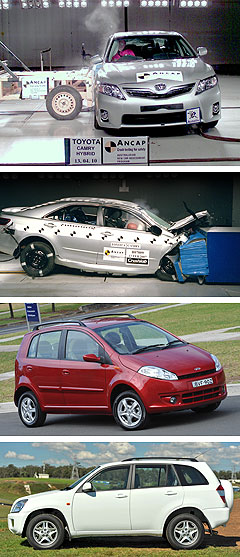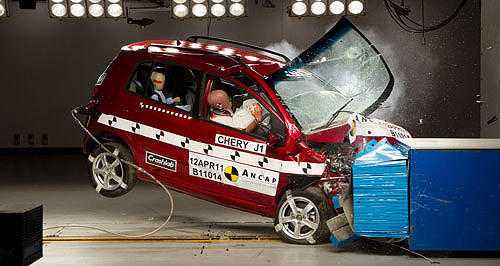Make / Model Search
News - Chery - J1Chery J1 scores three stars in crash testsCrushed Chery: The Chinese-built J1 light-car scored a mediocre three stars in its ANCAP crash test. ANCAP critical of Chery J1 crash protection after first Chinese car test10 May 2011 THE first Chinese-built passenger car to be crash tested under the independent Australasian New Car Assessment Program (ANCAP) – Chery’s pint-size J1 hatchback – has earned three stars, along with some stinging criticism for its safety shortcomings. ANCAP’S report released today says the J1 – the cheapest new car on the Australian market at $10,990 drive-away – suffered what ANCAP describes as a “loss of structural integrity” in the 64km/h front offset crash test conducted in April, resulting in “considerable risk for occupants”. The crash safety organisation also released a revised result for the Australian-made Camry and Camry Hybrid, elevating both mid-size sedans from four stars to five stars after Toyota made safety improvements in cars entering production at its Altona factory in Victoria this month, bringing it into line with the larger five-star Aurion sedan also produced at the plant. As GoAuto reported exclusively this week, the tweaks – which include a seatbelt reminder device for the front passenger seat and more crash protection for the driver’s knees – have been made just weeks before the Australian government introduces a mandatory five-star safety standard for all federal fleet passenger car purchases from July 1. Without the improvements, the Camry would have become the only Australian-built car to be excluded from federal fleet sales, putting a major hole in its sales volumes and giving rivals a free kick, at least until an all-new Camry arrives later this year and the next-generation Camry Hybrid follows it on sale in 2012.  Left: Toyota Camry hybrid ANCAP testing. Below: Chery J1 and J11 models. Left: Toyota Camry hybrid ANCAP testing. Below: Chery J1 and J11 models.While ANCAP welcomed the Camry into the five-star club, it dished out some tough love to Chery following the debut performance of China’s first passenger car in Australia, where Chery is distributed by the nation’s biggest independent importer, Ateco Automotive. ANCAP chairman Lauchlan McIntosh said the J1 offered poor protection against serious chest injury to the driver in both the front offset and side impact crash tests. “We were concerned over the lack of head-protecting side airbags and electronic stability control (ESC) on this model,” he said. “These life-saving features are available on competing models from other manufacturers – many of which have a five-star ANCAP rating.” The lack of ESC has precluded sales of the J1 and its J11 SUV sibling in Victoria, where roadworthy rules require all passenger vehicles to be fitted with the device, ahead of federal rules that will require ESC on all new cars registered nationally from November. Ateco Chinese brands spokesman Daniel Cotterill told GoAuto that Chery was working on ESC for the J1 and J11, and planned to have the revised vehicles in showrooms ahead of the Australian Design Rule deadline in November “as soon as they can reasonably get it done”. “It is not a bolt-on piece of technology,” he said. “It needs to be quite properly integrated into the whole engine management system and the anti-lock brakes and so on, and it needs to be thoroughly tested.” Mr Cotterill said Chery – which had sent two crash safety engineers to Australia to observe the J1 crash tests – would use the experience to improve its safety levels. “It gives them a real quick insight into it and, from where we sit, that’s going to result in rapid improvements via running changes to current models and, looking down the track, it will feed into the design of future models,” he said. “I want to emphasise that all Cherys on sale in Australia are fully compliant with Australian design rules, as they have to be.” Mr Cotterill described the crash tests as a fair result, adding: “It is better than I suspect a lot of people would have expected. It is a result that also could use some improvement.” In 2009, Ateco’s other brand, Great Wall Motors, had to recall its V240 ute after a seatbelt failed during ANCAP crash testing, in which it scored just two stars. Last year, Great Wall’s X240 SUV fared much better, scoring a commendable four stars in the ANCAP tests. The improvement to the Toyota Camry’s safety systems comes five years into the life of the current model and only months before the launch of the new-generation car. In 2006, Toyota said it was too difficult to add a passenger seat warning device and extra knee protection to the car – two improvements that would have addressed the major safety shortcomings of the vehicle as seen by ANCAP and potentially lifted it to five stars. The Camry Altise tested by ANCAP in 2006 scored 12.29 points out of a possible 16 in the offset crash test – short of the 12.5 necessary for five-star status. But even if it had made 12.5 points, it still would not have qualified for the top rank because ANCAP requires seatbelt warning devices on both front seats. Until now, the Camry had the device fitted only to the driver’s seat. Now, just days after the federal government announced that five stars would be the minimum safety standard for all passenger cars bought by the federal vehicle fleet from July 1, the Camry has been equipped with the passenger-side seatbelt warning device and extra padding to protect the driver’s knees. Toyota is a major fleet supplier to the federal government and its agencies, which, under guidelines laid down by former finance minister Lindsay Tanner last year, are required to pick from a select list of passenger cars, all supplied by the three Australian manufacturers, Toyota, GM Holden and Ford. The so-called Tier 1 cars – which departments and public service executives must choose from first – include all the Australian-made vehicles: Holden’s Commodore, Caprice and Cruze, Ford’s Falcon and Territory and Toyota’s Camry, Camry Hybrid and Aurion. If they cannot find a car from that list that suits their operational requirement, they are permitted to select from a range of imported cars with engines smaller than 2.4 litres. These cars on the Tier 2 list are all sold by the three local car-makers, but at least three – the Holden Barina and Captiva diesel and Toyota Yaris – currently fall short of the five-star requirement. The four-star Barina and Yaris are both expected to be replaced with all-new models later this year, rectifying that situation, but it is unclear if the Captiva, which was updated earlier this year in a Series II facelift, can be elevated to five stars before the July 1 deadline. This would make the Ford Territory the only qualified SUV in the two-tier list. Toyota Australia senior executive director sales and marketing David Buttner said the ANCAP testing had confirmed that Camry and Hybrid Camry were strong cars that provided excellent protection for occupants. “This was no surprise because Toyota’s own extensive tests ensure all our vehicles meet or exceed safety standards in every country in which they are sold,” he said.  Read more9th of May 2011  Five-star Camry in the wingsToyota Camry set to meet federal fleet five-star safety rule with last-minute tweak28th of April 2011  Chery hits new lowChina’s Chery slashes Australia's lowest new car price to just $10,990 drive-away18th of April 2011  Chery readies Corolla fighterNext instalment of Chery’s Australian invasion, China’s J3 hatchback, is ready24th of February 2011  Chery releases Australia’s cheapest SUVSub-$20,000 SUV launched as Chery becomes Australia’s latest Chinese brand |
Click to shareChery articlesResearch Chery Motor industry news |











Facebook Twitter Instagram